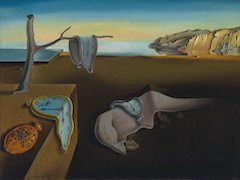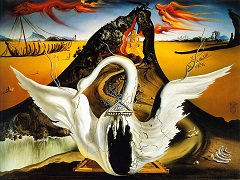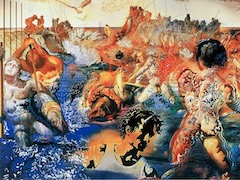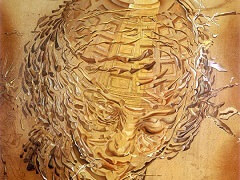Metamorphosis of Narcissus 1937 by Salvador Dali
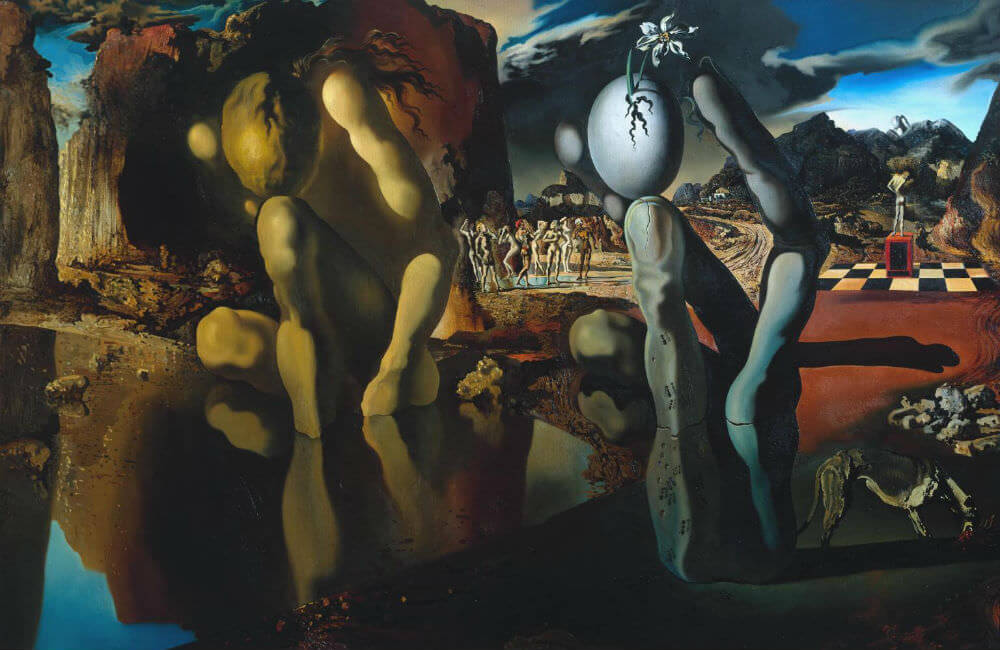
Metamorphosis of Narcissus is Dali's interpretation of the Greek myth of Narcissus. Narcissus was a youth of great beauty who loved only himself and broke the hearts of many lovers. The gods punished him by letting him see his own reflection in a pool. He fell in love with it, but discovered he could not embrace it and died of frustration. Relenting, the gods immortalized him as the narcissus (daffodil) flower. For this picture Dali used a meticulous technique which he described as 'hand-painted color photography' to depict with the hallucinatory effect the transformation of Narcissus, kneeling in the pool, into the hand holding the egg and flower. Narcissus as he was before his transformation is seen posing in the background. The play with 'double images' sprang from Dali's fascination with hallucination and delusion.
This was Dali's first painting to be made entirely in accordance with the paranoiac-critical method, which the artist described as a 'Spontaneous method of irrational knowledge, based on the critical-interpretative association of the phenomena of delirium' (The Conquest of the Irrational, published in The Secret Life of Salvador Dali, New York 1942). Robert Descharnes noted that this painting meant a great deal to Dali, as it was the first Surrealist work to offer a consistent interpretation of an irrational subject.
The artist said to Descharnes of this picture:
A painting is shown and explained to Dr. Freud.
Pedagogical presentation of the myth of narcissism, illustrated by a poem written at the same time.
In this poem and this painting, there is death and fossilization of Narcissus.
The poem to which Dali referred was published in 1937, in a small book by the artist entitled Metamorphosis of Narcissus. The book also contains two explanatory notes printed facing a color reproduction of the painting,
the first of which reads:
WAY OF VISUALLY OBSERVING THE COURSE OF THE METAMORPHOSIS OF NARCISSUS REPRESENTED IN THE PRINT ON THE OPPOSITE PAGE:
If one looks for some time, from a slight distance and with a certain 'distant fixedness', at the hypnotically immobile figure of Narcissus, it gradually disappears until at last, it is completely invisible.
The metamorphosis of the myth takes place at that precise moment, for the image of Narcissus is suddenly transformed into the image of a hand that rises out of his own reflection. At the tips of its fingers the hand is
holding an egg, a seed, a bulb from which will be born the new narcissus - the flower. Besides, it can be seen the limestone sculpture of the hand - the fossil hand of the water holding the blown flower.
When he met Sigmund Freud in London in 1938, Dali took this picture with him as an example of his work, as well as a magazine containing an article he had written on paranoia.
A dramatic jump into the future, Dali's psychedelic, Surrealist version of the Narcissus myth claims to take inspiration from Narcissus by Renaissance artist Caravaggio, but the viewer is hard-pressed to see it.
Dali intended this painting to be viewed while reading his poem, and to be regarded in a state of "distracted fixation" whereby the image would disappear as it was being watched.

